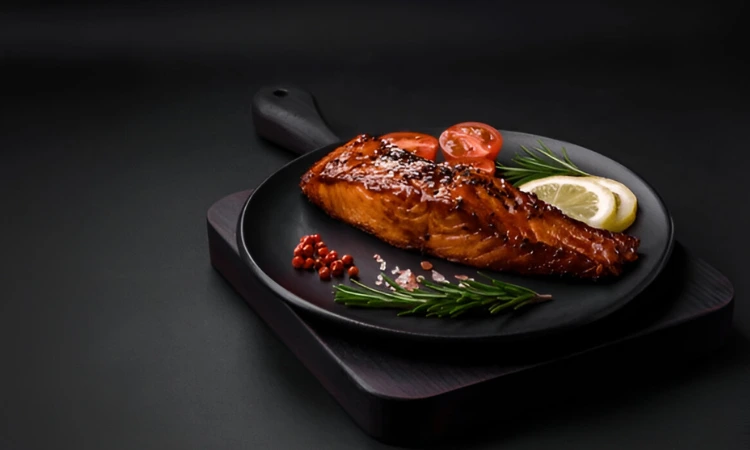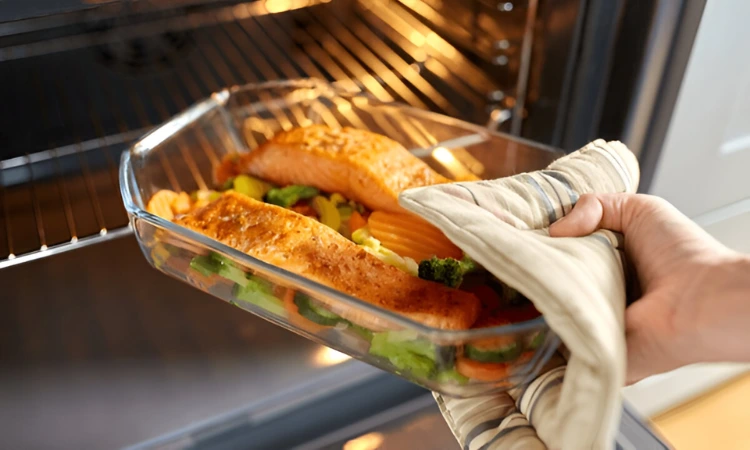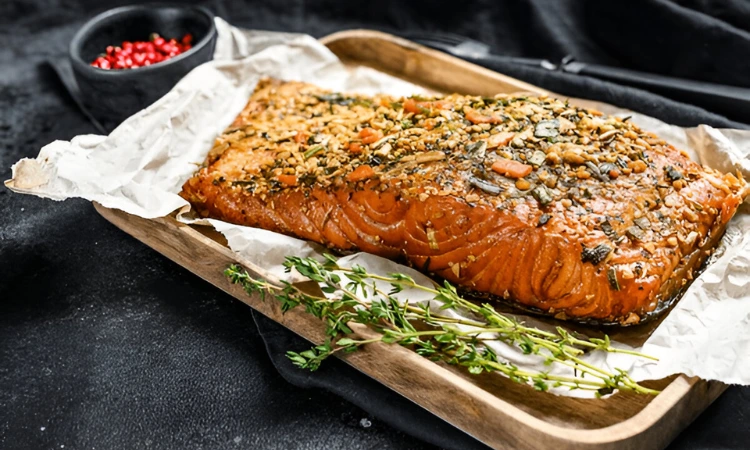Wondering how to reheat salmon without turning it into a dry, fishy mess? Don’t worry—you absolutely can!
Whether it’s last night’s dinner, your meal prep for the week, or even that fancy restaurant salmon you saved, there’s a way to bring it back to life without ruining the taste.
The best way to reheat salmon depends on a few smart steps that protect moisture, lock in flavor, and keep it safe.
Reheating cooked salmon doesn’t have to be risky or complicated—you just need to know the proper method. Let’s fix dry salmon problems for good, starting now.

Is It Safe to Reheat Salmon?
Yes, reheating salmon is safe if done correctly. Many wonder, can you reheat salmon without losing quality? The key is using the right temperature and method.
Following food safety guidelines and heating salmon to the right temperature prevents foodborne illness and keeps your leftovers delicious.
Let’s explore the key safety tips to keep your salmon leftovers tasty and healthy.
- According to the FDA, salmon leftovers should be reheated to an internal temperature of 165°F (74°C) to kill harmful bacteria.
- Use a food thermometer to check. Proper reheating ensures safety and keeps your salmon tasty.
- Always store salmon leftovers in the fridge within two hours of cooking.
How Many Times Can You Reheat Salmon?

It’s best to reheat salmon only once. Each time you cool and reheat leftovers, the risk of bacterial growth increases, and the quality declines.
Reheating salmon multiple times can cause dryness, flavor loss, and food safety issues. When in doubt, throw it out!
5 Best Ways to Reheat Salmon
Here are the top methods to reheat salmon without drying it out, each with its benefits and things to watch for.
How To Reheat Salmon in the Oven?
The oven is the best way to reheat leftover salmon because it preserves flavor and texture.
Preheat to 275°F, wrap salmon in foil with a splash of water or lemon juice, and heat for 10-15 minutes. This method heats evenly without drying out your fish.
How To Reheat Salmon in the Air Fryer?
Using an air fryer is quick and can crisp the edges, but you must add moisture like olive oil or lemon slices to avoid dryness.
Reheat at 300°F for 5-7 minutes. Perfect for those who want speed with a little crunch.
How To Reheat Salmon in the Microwave?
The fastest way, but requires extra care to avoid rubbery salmon.
Cover with a damp paper towel and heat on medium power in 30-second bursts until warm. This method is handy but easy to overcook.
Use low power and short bursts, and cover with a damp paper towel to keep moisture.
How To Reheat Salmon in the Skillet?
Reheating salmon in a skillet gives crispy edges and good flavor.
Use low heat and a little oil or butter, cover the pan, and warm for 3-5 minutes. This chef-style technique balances texture and taste well.
How To Reheat Salmon in the Steamer/Pan with Lid?
Steaming keeps salmon moist and tender by gently warming it with steam.
Place salmon in a steamer basket or covered pan with a bit of water, heat for 5-8 minutes, and enjoy juicy, soft salmon every time.
Each method helps you reheat salmon like a chef, making your leftovers delicious again without drying out your fish.
How to Warm Up Salmon Without Appliances?

If you’re on the go, packing a lunch, or just don’t have access to full kitchen gear, don’t worry. You can still warm up salmon without a microwave or fancy appliances.
These clever hacks are great for travel, small kitchens, or reheating leftover salmon safely with what you have.
Toaster Oven Method
Using a toaster oven is a compact and practical option for toaster oven salmon reheating.
You can wrap your salmon in foil, set the toaster oven to 275°F, and heat it for 10–12 minutes. This gently warms the salmon without drying it out.
Sous Vide Style (Hot Water Method)
No sous vide machine? No problem. Place the salmon in a sealed food-safe bag and submerge it in a hot (not boiling) water bowl. Let it sit for about 10–15 minutes.
This evenly warms the salmon while keeping it moist and tender, mimicking sous vide reheating salmon techniques.
This gentle technique works great when you need soft, juicy salmon without overcooking.
Room Temperature Trick
If you’re planning to eat your salmon cold, leave it at room temperature for 20–30 minutes before eating.
This helps bring it to a more pleasant temperature without reheating. Just make sure it’s been stored safely beforehand.
These hacks work well for warming up salmon gently, without drying it out, even without your usual kitchen tools.
How to Keep Your Salmon Moist and Flavorful?

Over the years, I’ve ruined salmon more times than I’d like to admit. But with some simple tricks, I finally learned how to retain moisture in salmon and bring back that juicy, flavorful bite, without drying it out.
Add Lemon Slices, Broth, or Olive Oil
Trust me, a drizzle of olive oil or a splash of broth works wonders. I sometimes add lemon slices, too—they add moisture and a fresh kick.
Wrap in Foil for Insulation
Wrapping your salmon in foil has been a game-changer for me. It traps the steam inside and helps with low-temperature reheating, which keeps the fish tender.
Avoid Overcooking at High Heat
I’ve learned the hard way—high heat is your enemy. Reheat your salmon low and slow. Aim for 275°F in the oven or gentle heat on the stovetop to avoid turning it rubbery.
How to Reheat Different Types of Salmon?
Each type of salmon needs a slightly different touch. These tips help you reheat grilled, baked, or smoked salmon without losing flavor or moisture.
How To Reheat Grilled Salmon?
Wrap the grilled salmon in foil to keep that smoky edge and reheat it in the oven at low heat.
How To Reheat Pan-Seared Salmon?
Warm it in a skillet on low heat with a splash of oil to restore that crispy outside and juicy inside.
How To Reheat Baked or Poached Salmon?
These delicate types reheat best when covered with foil in the oven. Add broth to keep moisture locked in.
How To Reheat Smoked Salmon (Hot vs. Cold)?
Hot-smoked salmon can be gently warmed in foil. Cold-smoked salmon is best enjoyed cold—don’t reheat it, or it will change texture.
How to Reheat Frozen Cooked Salmon?
Thaw overnight in the fridge. For best results, reheat in the oven wrapped in foil with a bit of broth to prevent drying out.
How Long Does Reheated Salmon Last?
Leftover salmon in the fridge usually lasts 3 to 4 days. Once you reheat it, it’s best to eat it within 24 hours to keep it safe and tasty.
Avoid reheating salmon more than once to prevent drying out and reduce food safety risks.
Can You Eat Cold Salmon?
Yes, you can eat cold salmon—and sometimes, it’s actually the better choice. If your salmon has been appropriately stored, eating it cold can be safe, convenient, and surprisingly tasty. It’s perfect for quick meals, meal prep, or even a high-protein snack.
Benefits of Eating Cold Salmon:
- Cold salmon works wonderfully in salads, wraps, or grain bowls—no need to reheat.
- Reheating sometimes changes the taste. Cold salmon keeps its rich flavor and smooth texture intact.
- Skip the reheating step—ideal for busy days or packed lunches.
- You retain the omega-3s, protein, and healthy fats without risking overcooking.
- Cold salmon tends to smell milder than when reheated, making it office- or travel-friendly.
Leftover Salmon Ideas If You Don’t Want to Reheat It

No microwave? No problem. These cold salmon meal ideas and reheated salmon ideas are tasty, quick, and waste-free.
Cold Salmon Salad
Toss cold salmon with greens, cherry tomatoes, cucumbers, and vinaigrette for a refreshing, protein-packed lunch.
Salmon Wrap
Layer salmon with hummus, spinach, and shredded carrots in a wrap—perfect for healthy leftover meals on the go.
Cold Salmon Pasta
Mix salmon with cold pasta, olive oil, lemon juice, and herbs for a light, tangy dish.
Salmon Tacos
Use salmon in soft tacos with slaw, avocado, and a squeeze of lime for a flavorful twist.
Reduce food waste by repurposing leftover salmon into easy, creative meals. Instead of tossing your salmon, turn it into something new and delicious.
Repurposing leftovers is smart—it’s also a great way to save money, reduce food waste, and enjoy easy, high-protein meals without extra effort.
Signs Your Salmon Is No Longer Safe to Eat
Look for these warning signs before reheating or eating leftover salmon:
- Off or sour smell, stronger than usual fishiness
- A slimy or sticky texture on the surface
- Discoloration, such as dull or grayish patches
- Mold or visible spots of fuzz
If you notice any of these, it’s safer not to eat the salmon leftovers.
Frequently Asked Questions About Reheating Salmon
Is it safe to reheat salmon?
Yes, reheating salmon is safe if it reaches an internal temperature of 165°F (74°C). This ensures any harmful bacteria are killed and your salmon stays delicious.
How can I reheat salmon without drying it out?
To keep salmon moist, reheat it gently at low temperatures and wrap it in foil with a splash of water or lemon juice. Avoid high heat to prevent drying and preserve flavor.
Can I reheat salmon in the microwave?
Yes, but do it carefully using low power and short bursts while covering the salmon to retain moisture. This prevents the fish from becoming rubbery or overcooked.
How many times can I safely reheat salmon?
It’s best to reheat salmon only once to minimize food safety risks and maintain quality. Repeated reheating can cause dryness and increase the chance of bacterial growth.
Can I eat leftover salmon cold?
Absolutely, leftover salmon can be eaten cold if it’s been stored properly in the fridge. Cold salmon is excellent for salads or wraps and retains moisture and flavor.
How to store leftover salmon?
Leftover salmon should be stored in an airtight container in the fridge within two hours of cooking. Properly chilling it helps maintain freshness for up to 3-4 days.
What is the best way to reheat leftover salmon?
The best way is to reheat salmon slowly in the oven, wrapped in foil with some moisture added. This method locks in flavor and prevents the fish from drying out.
How long does reheated salmon last in the fridge?
For best safety and taste, reheated salmon should be eaten within 24 hours. Storing it longer can lead to spoilage and foodborne illness risks.
Final Thoughts
Learning how to reheat salmon correctly doesn’t have to be tricky or risky.
You can enjoy your leftover salmon without sacrificing flavor or texture by following a few simple tips and choosing the best reheating method.
Always remember food safety, and your salmon meals will remain just as delicious and satisfying as the first time.
Related : 3 Easy Meal Prep Ideas With Salmon
Related : How to Reheat Salmon Like a Pro
Related : Baked Fish in Foil With Vegetables : Ready in 25 Minutes

